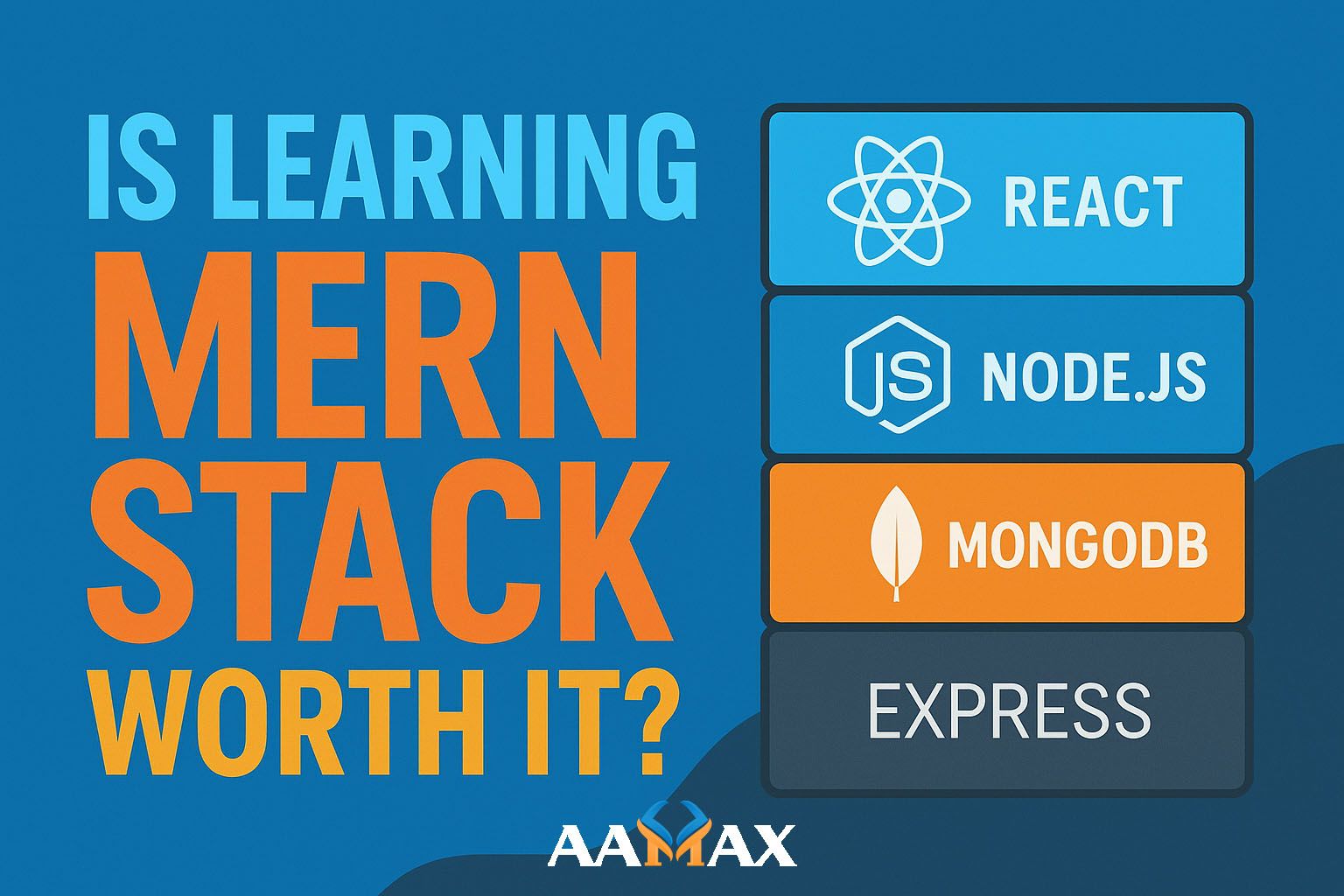
Is Learning MERN Stack Worth It
The world of web development is constantly evolving, and developers are always looking for technologies that are fast, scalable, and versatile. One such technology stack that has gained massive popularity in recent years is the MERN stack. It consists of MongoDB, Express.js, React.js, and Node.js — a combination that allows developers to build full-stack web applications using a single programming language: JavaScript.
But with so many frameworks and technologies available today, many aspiring developers often ask — Is learning the MERN stack really worth it? In this article, we’ll take a deep dive into why MERN has become a dominant force in the web development world, its real-world applications, advantages, potential challenges, and why it’s still one of the best choices for developers in 2025 and beyond.
Understanding the MERN Stack
Before determining if it’s worth learning, let’s first understand what each component of the MERN stack does:
- MongoDB – A NoSQL database that stores data in a flexible, JSON-like format. It’s ideal for handling large-scale, unstructured data.
- Express.js – A backend web framework for Node.js that simplifies the creation of APIs and server-side applications.
- React.js – A JavaScript library developed by Facebook (now Meta) used to build fast and dynamic user interfaces for web applications.
- Node.js – A JavaScript runtime that allows you to run JavaScript on the server side, making it possible to build scalable backend applications.
What makes the MERN stack unique is that it uses JavaScript for both frontend and backend development, eliminating the need for developers to switch between different languages.
Why MERN Stack Has Become So Popular
The MERN stack’s popularity didn’t happen by chance. It is backed by several practical advantages that make it a preferred choice among both developers and companies.
1. Unified Language Across the Stack
One of the biggest reasons developers love MERN is the fact that JavaScript powers the entire stack. From the user interface to the backend server, everything runs on JavaScript. This makes development faster, easier to debug, and more consistent.
2. Open Source and Supported by a Huge Community
All components of the MERN stack are open source, meaning they are free to use and have massive developer communities contributing to their growth. This means more libraries, tools, tutorials, and community support are available for anyone learning or working with MERN.
3. High Demand for Full-Stack Developers
With startups and enterprises focusing on efficiency, the demand for full-stack developers who can manage both frontend and backend tasks is higher than ever. MERN developers, being versatile in both areas, are highly valued in the job market.
4. Flexibility and Scalability
MERN is known for building applications that can scale easily. From small single-page apps to large enterprise solutions, MERN can handle it all. MongoDB’s flexible schema design and Node’s non-blocking architecture make scalability a breeze.
5. Excellent Performance and Speed
Node.js is known for its event-driven, non-blocking I/O model, which ensures that applications handle multiple requests simultaneously without slowing down. Combined with React’s virtual DOM for rendering efficiency, MERN apps offer outstanding performance.
Career Opportunities for MERN Developers
If you’re thinking about learning the MERN stack, you’ll be pleased to know that career prospects are excellent. Companies of all sizes — from startups to large tech firms — are hiring MERN developers due to the stack’s versatility.
Some of the common job roles include:
- Full Stack Developer
- Frontend Developer (React)
- Backend Developer (Node.js/Express)
- JavaScript Engineer
- Web Application Developer
Salary Expectations
Salaries for MERN developers vary by region, but generally, they are among the higher-paid web developers. For instance:
- In the United States, MERN developers earn between $90,000 to $140,000 per year on average.
- In India, MERN developers can earn anywhere from ₹5 to ₹15 lakhs per annum, depending on experience.
- In Europe and Asia-Pacific, demand for MERN skills continues to rise with competitive pay scales.
Freelancing and Remote Work Opportunities
Because MERN is used globally, developers can easily find remote projects or freelancing opportunities. Platforms like Upwork, Fiverr, and Toptal have thousands of MERN-related projects every month, making it a great choice for independent developers too.
The Learning Curve — Is It Hard to Learn MERN?
MERN is relatively beginner-friendly, especially for those who already have some experience with JavaScript. However, mastering it requires understanding several concepts and technologies simultaneously.
What You’ll Need to Learn
- JavaScript and ES6+ — Core fundamentals for everything in the stack.
- React.js — Understanding components, state management, hooks, and routing.
- Node.js and Express — Server-side programming, API creation, middleware, and routing.
- MongoDB — Database management, schema design, and CRUD operations.
- Version Control (Git) and deployment — Essential for collaboration and launching applications.
While this might sound like a lot, the key advantage is that everything revolves around one language — JavaScript. Once you get comfortable with it, learning each part of the MERN stack becomes much easier.
Real-World Use Cases of MERN Stack
The MERN stack is not just a theoretical concept; it’s powering real-world applications used by millions. Here are a few common use cases:
- E-commerce platforms — Websites that handle product listings, user accounts, and payments.
- Social media applications — Interactive platforms with real-time updates, messaging, and news feeds.
- Project management tools — Platforms that allow collaboration, task tracking, and reporting.
- Educational apps — Learning management systems (LMS) and online classroom tools.
- Healthcare and SaaS products — Secure, data-driven applications for different industries.
The flexibility of MERN makes it suitable for virtually any kind of web application — from small startups to global enterprises.
Advantages of Learning MERN Stack
Let’s look at why investing your time in learning MERN is still worth it today.
1. One Language for Everything
You don’t need to learn separate languages for backend (like PHP or Python) and frontend (like Angular or Vue). MERN lets you use JavaScript across the entire project.
2. Fast Prototyping and Development
With pre-built libraries, reusable components, and modular architecture, you can quickly build prototypes or MVPs (Minimum Viable Products). This is particularly valuable for startups.
3. Huge Ecosystem and Community Support
The MERN stack’s open-source nature means constant updates, plugins, and third-party tools are always available, making development easier and faster.
4. Modern Development Practices
MERN encourages modern approaches like RESTful APIs, microservices, and responsive UI design — skills that are in high demand across industries.
5. Future-Proof Skills
Since JavaScript remains one of the most widely used languages worldwide, learning MERN ensures your skills stay relevant for years to come.
Challenges of Learning the MERN Stack
While MERN offers countless benefits, it also comes with a few challenges developers should be aware of:
- Steep Learning Curve for Beginners – Understanding both frontend and backend technologies can be overwhelming initially.
- Constantly Evolving Tools – The JavaScript ecosystem changes rapidly, so developers must continuously update their knowledge.
- Performance Optimization – Handling large-scale apps requires optimization in MongoDB queries, API design, and React rendering.
- Security Concerns – Like all full-stack systems, proper security implementation (authentication, authorization, data validation) is essential.
Comparing MERN with Other Stacks
When evaluating if learning MERN is worth it, it helps to compare it with other popular stacks:
| Stack | Technologies | Best For | Key Advantage | |-------|---------------|-----------|----------------| | MERN | MongoDB, Express, React, Node | Full-stack web apps | Unified JavaScript environment | | MEAN | MongoDB, Express, Angular, Node | Enterprise apps | Strong structure & TypeScript | | LAMP | Linux, Apache, MySQL, PHP | Traditional web dev | Well-established and stable | | Django Stack | Python, Django, PostgreSQL | Data-driven apps | Rapid development and clean syntax |
From the table, you can see that MERN’s key strength lies in its JavaScript ecosystem and flexibility, making it ideal for modern, dynamic web applications.
The Future of MERN Stack
As we move into 2025 and beyond, the future of MERN looks incredibly promising. With more businesses moving online and adopting JavaScript frameworks for full-stack development, MERN will continue to thrive.
React’s dominance in the frontend world and Node’s continued evolution mean that the MERN stack isn’t going anywhere soon. In fact, many tech giants and startups are continuing to build and maintain their platforms using MERN because of its speed, simplicity, and developer-friendly environment.
Why You Should Learn MERN Stack in 2025
If you’re on the fence about whether to invest your time in learning MERN, consider these points:
- It’s one of the most in-demand stacks globally.
- You can build real-world projects quickly, from concept to deployment.
- MERN developers are highly employable and command competitive salaries.
- The skills you gain are transferable to other technologies like Next.js or React Native.
- It offers a balanced learning curve — challenging yet rewarding.
Why Businesses Choose MERN Stack
For businesses, the MERN stack offers cost-efficiency, speed, and scalability. It’s perfect for startups that want to get their product to market quickly without sacrificing performance or design quality.
Key Business Benefits:
- Faster Development Cycles — Thanks to reusable React components and Node.js performance.
- Cross-Platform Compatibility — Works seamlessly with cloud services and mobile frameworks.
- Reduced Development Cost — Only one team needs to manage the full stack.
- Scalable Architecture — Easily handle growing user bases.
Because of these reasons, many digital agencies and enterprises now prefer the MERN stack for modern web development projects.
Partner with AAMAX for MERN Stack Development
If you’re planning to build a MERN-based application or looking for expert developers to bring your vision to life, consider partnering with AAMAX. AAMAX is a full-service digital marketing and web development company offering MERN Stack Development, SEO, and Digital Marketing Services.
Their skilled developers specialize in building robust, scalable, and visually stunning applications that deliver measurable business results. Whether it’s a SaaS platform, eCommerce site, or a business portal, AAMAX provides end-to-end solutions — from strategy to deployment.
Conclusion
So, is learning MERN stack worth it? Absolutely. The MERN stack empowers developers to build everything from dynamic websites to enterprise-grade applications using a single, unified language. With excellent community support, career opportunities, and scalability, MERN remains a powerful choice for 2025 and beyond.
For businesses, it offers speed, flexibility, and cost-effective solutions that can scale with demand. And for individuals, it opens doors to some of the best roles in web development today.
If you’re ready to future-proof your skills or bring your next digital idea to life, learning MERN or working with experts like AAMAX is one of the smartest decisions you can make.







